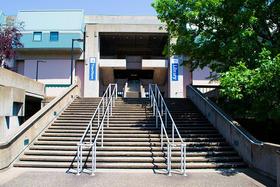- Ranger College, a public two-year college serving a five-county area in North Central Texas, extends educational opportunities to all students seeking the academic, vocational, technical, or developmental program offered. The open admission policy makes the programs of the college available to all students who wish to further their education in a small college setting.
School Highlights
Ranger College serves 2,893 students (29% of students are full-time).
The college's student-teacher ratio of 16:1 is lower than the state community college average of 23:1.
Minority enrollment is 43% of the student body (majority Hispanic), which is less than the state average of 74%.
Quick Facts (2025-26)
- Enrollment: 2,893 students
- In-state tuition: $3,600
- Out-state tuition: $4,710
- Student-teacher ratio: 16:1
- Minority enrollment: 43%
- Source: Integrated Postsecondary Education Data System (IPEDS)
School Overview
The teacher population of 186 teachers has stayed relatively flat over five years.
Ranger College
(TX) Community College Avg.
Carnegie Classification
Associate's Colleges: High Transfer-High Traditional
Baccalaureate/Associate's Colleges: Associate's Dominant
Institution Level
At least 2 but less than 4 years
At least 2 but less than 4 years
Institution Control
Public
Public
Total Faculty
186 staff
262 staff
Student Body
The student population of Ranger College has grown by 32% over five years.
The student-teacher ratio of 16:1 has increased from 12:1 over five years.
The Ranger College diversity score of 0.56 is less than the state average of 0.70. The school's diversity has stayed relatively flat over five years.
Total Enrollment
2,893 students
4,931 students
Student-Teacher Ratio
16:1
23:1
# Full-Time Students
846 students
909 students
# Part-Time Students
2,047 students
4,022 students
# Enrollment Undergraduate
289 students
403 students
# Full-Time Undergraduate Students
846 students
890 students
# Full-Time Graduate Students
n/a
40 students
# Part-Time Undergraduate Students
2,047 students
4,166 students
# Part-Time Graduate Students
n/a
47 students
Total Dormitory Capacity
368 students
252 students
% American Indian/Alaskan
n/a
n/a
% Asian
1%
6%
% Hispanic
32%
46%
% Black
4%
13%
% White
57%
26%
% Hawaiian
n/a
n/a
% Two or more races
4%
3%
% Non Resident races
2%
2%
% Unknown races
n/a
4%
Diversity Score
0.56
0.70
College Completion Rate (Students who graduate in less than 4 years)
43%
55%
College Completion Rate (Students who graduate in 4 years or more than 4 years)
n/a
34%
Average Graduate Earnings (10 Years)
$32,400
$34,600
Tuition and Acceptance Rate
The public in-state tuition of $3,600 is less than the state average of $3,764. The in-state tuition has declined by 20% over four years.
The public out-state tuition of $4,710 is less than the state average of $6,054. The out-state tuition has declined by 21% over four years.
In-State Tuition Fees
$3,600
$3,764
Out-State Tuition Fees
$4,710
$6,054
% Students Receiving Some Financial Aid
78%
84%
Median Debt for Graduates
$9,166
$10,765
Median Debt for Dropouts
$5,338
$5,500
Acceptance Rate
n/a
84%
Source: 2024 (or latest year available) Integrated Postsecondary Education Data System (IPEDS)
School Notes
- Ranger College is one of the oldest public two-year colleges in continuous operation in the state of Texas. Its history actually predates the legislation authorizing and establishing junior colleges in the state. In August 1925, the Board of Education of the Ranger Public Schools voted to proceed with plans for establishment of a junior college. On September 13, 1926, the College opened with thirty students enrolled. The College operated under the supervision of a college council composed of three members of the Board of Education and nine other Ranger citizens. The College was recognized by the State Department of Education on March 23, 1927. The first state statute authorizing the establishment of a junior college was passed by the 41st Texas Legislature in 1929. Ranger College occupies a 50-acre campus within the city limits of Ranger, an Eastland County community of approximately 3,000 people located just north of Interstate 20 between Fort Worth and Abilene. The beautifully wooded rolling hills and several lakes provide ample opportunities for hunting, fishing, and outdoor recreation, while the City of Ranger has excellent schools and churches and a congenial, supportive citizenry. Its proximity to the Dallas/Fort Worth Metroplex is another advantage. College classes are also offered at numerous off-campus locations in neighboring cities. In Brown County, a Vocational Nursing Program is offered in Early and a Cosmetology Program is offered in Brownwood, the county seat. Continuing Education and a limited number of academic courses are offered in Early and in Stephenville, the home of Tarleton State University. These programs have an annual enrollment in excess of 125 students. A program in academic studies is offered at the Comanche Center in Comanche, the county seat of Comanche County where annual enrollments average about 400 students. Comanche, located 25 miles from Brownwood, is a thriving city of 4,000 population with an economy based on food processing, livestock feed processing, agriculture, and a lively trade in both peanuts and pecans. Ranger College is accredited by the Commission on Colleges of the Southern Association of Colleges and Schools to award Certificates and Associate Degrees.
Frequently Asked Questions
How much does Ranger College cost?
Ranger College's tuition is approximately $3,600 for In-State students and $4,710 for Out-State students.
Recent Articles

Student Success Programs That Actually Work at Community Colleges
Discover evidence-based student success programs at community colleges for 2025, with outcomes, examples, and actionable strategies.

Best Community Colleges by Career Path in 2025
Explore top community colleges for career-training programs in 2025, including healthcare, IT, skilled trades and business pathways.

Dual Enrollment in High School: Benefits, Risks & Real Student Results
Explore the pros and cons of dual enrollment in high school, real outcomes for students in 2025, and how to decide if it’s right for you.









